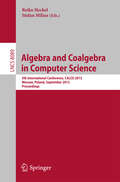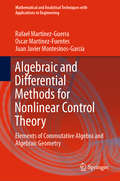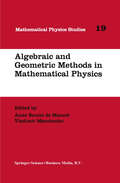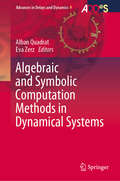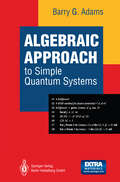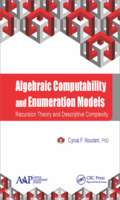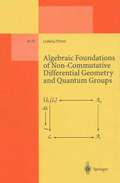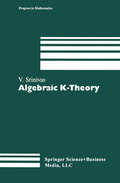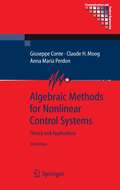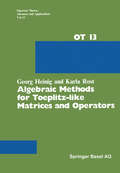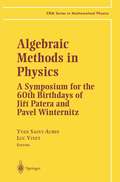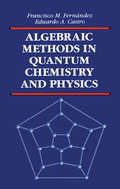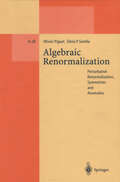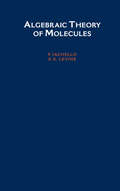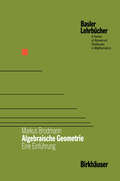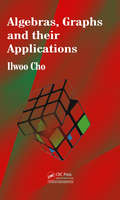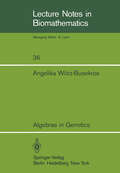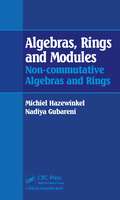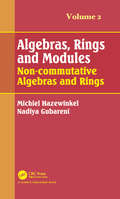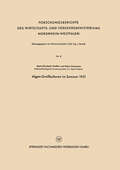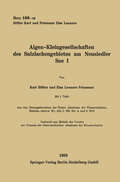- Table View
- List View
Algebra and Coalgebra in Computer Science: 5th International Conference, CALCO 2013, Warsaw, Poland, September 3-6, 2013, Proceedings (Lecture Notes in Computer Science #8089)
by Reiko Heckel Stefan MiliusThis book constitutes the refereed proceedings of the 5th International Conference on Algebra and Coalgebra in Computer Science, CALCO 2013, held in Warsaw, Poland, in September 2013. The 18 full papers presented together with 4 invited talks were carefully reviewed and selected from 33 submissions. The papers cover topics in the fields of abstract models and logics, specialized models and calculi, algebraic and coalgebraic semantics, system specification and verification, as well as corecursion in programming languages, and algebra and coalgebra in quantum computing. The book also includes 6 papers from the CALCO Tools Workshop, co-located with CALCO 2013 and dedicated to tools based on algebraic and/or coalgebraic principles.
Algebraic and Differential Methods for Nonlinear Control Theory: Elements of Commutative Algebra and Algebraic Geometry (Mathematical and Analytical Techniques with Applications to Engineering)
by Rafael Martínez-Guerra Oscar Martínez-Fuentes Juan Javier Montesinos-GarcíaThis book is a short primer in engineering mathematics with a view on applications in nonlinear control theory. In particular, it introduces some elementary concepts of commutative algebra and algebraic geometry which offer a set of tools quite different from the traditional approaches to the subject matter. This text begins with the study of elementary set and map theory. Chapters 2 and 3 on group theory and rings, respectively, are included because of their important relation to linear algebra, the group of invertible linear maps (or matrices) and the ring of linear maps of a vector space. Homomorphisms and Ideals are dealt with as well at this stage. Chapter 4 is devoted to the theory of matrices and systems of linear equations. Chapter 5 gives some information on permutations, determinants and the inverse of a matrix. Chapter 6 tackles vector spaces over a field, Chapter 7 treats linear maps resp. linear transformations, and in addition the application in linear control theory of some abstract theorems such as the concept of a kernel, the image and dimension of vector spaces are illustrated. Chapter 8 considers the diagonalization of a matrix and their canonical forms. Chapter 9 provides a brief introduction to elementary methods for solving differential equations and, finally, in Chapter 10, nonlinear control theory is introduced from the point of view of differential algebra.
Algebraic and Geometric Methods in Mathematical Physics: Proceedings of the Kaciveli Summer School, Crimea, Ukraine, 1993 (Mathematical Physics Studies #19)
by Anne Boutet De Monvel V. A. MarchenkoProceedings of the Kaciveli Summer School, Crimea, Ukraine, 1993
Algebraic and Symbolic Computation Methods in Dynamical Systems (Advances in Delays and Dynamics #9)
by Alban Quadrat Eva ZerzThis book aims at reviewing recent progress in the direction of algebraic and symbolic computation methods for functional systems, e.g. ODE systems, differential time-delay equations, difference equations and integro-differential equations. In the nineties, modern algebraic theories were introduced in mathematical systems theory and in control theory. Combined with real algebraic geometry, which was previously introduced in control theory, the past years have seen a flourishing development of algebraic methods in control theory. One of the strengths of algebraic methods lies in their close connections to computations. The use of the above-mentioned algebraic theories in control theory has been an important source of motivation to develop effective versions of these theories (when possible). With the development of computer algebra and computer algebra systems, symbolic methods for control theory have been developed over the past years. The goal of this book is to propose a partial state of the art in this direction. To make recent results more easily accessible to a large audience, the chapters include materials which survey the main mathematical methods and results and which are illustrated with explicit examples.
Algebraic Approach to Simple Quantum Systems: With Applications to Perturbation Theory
by Barry G. AdamsThis book provides an introduction to the use of algebraic methods and sym bolic computation for simple quantum systems with applications to large order perturbation theory. It is the first book to integrate Lie algebras, algebraic perturbation theory and symbolic computation in a form suitable for students and researchers in theoretical and computational chemistry and is conveniently divided into two parts. The first part, Chapters 1 to 6, provides a pedagogical introduction to the important Lie algebras so(3), so(2,1), so(4) and so(4,2) needed for the study of simple quantum systems such as the D-dimensional hydrogen atom and harmonic oscillator. This material is suitable for advanced undergraduate and beginning graduate students. Of particular importance is the use of so(2,1) in Chapter 4 as a spectrum generating algebra for several important systems such as the non-relativistic hydrogen atom and the relativistic Klein-Gordon and Dirac equations. This approach provides an interesting and important alternative to the usual textbook approach using series solutions of differential equations.
Algebraic Computability and Enumeration Models: Recursion Theory and Descriptive Complexity
by Cyrus F. NouraniThis book, Algebraic Computability and Enumeration Models: Recursion Theory and Descriptive Complexity, presents new techniques with functorial models to address important areas on pure mathematics and computability theory from the algebraic viewpoint. The reader is first introduced to categories and functorial models, with Kleene algebra examples
Algebraic Foundations of Non-Commutative Differential Geometry and Quantum Groups (Lecture Notes in Physics Monographs #39)
by Ludwig PittnerQuantum groups and quantum algebras as well as non-commutative differential geometry are important in mathematics and considered to be useful tools for model building in statistical and quantum physics. This book, addressing scientists and postgraduates, contains a detailed and rather complete presentation of the algebraic framework. Introductory chapters deal with background material such as Lie and Hopf superalgebras, Lie super-bialgebras, or formal power series. Great care was taken to present a reliable collection of formulae and to unify the notation, making this volume a useful work of reference for mathematicians and mathematical physicists.
Algebraic Methods for Nonlinear Control Systems (Communications and Control Engineering)
by Giuseppe Conte Claude H. Moog Anna Maria PerdonThis is a self-contained introduction to algebraic control for nonlinear systems suitable for researchers and graduate students. It is the first book dealing with the linear-algebraic approach to nonlinear control systems in such a detailed and extensive fashion. It provides a complementary approach to the more traditional differential geometry and deals more easily with several important characteristics of nonlinear systems.
Algebraic Methods for Toeplitz-like Matrices and Operators (Operator Theory: Advances and Applications #13)
by G. Heinig RostAlgebraic Methods in Physics: A Symposium for the 60th Birthdays of Ji?í Patera and Pavel Winternitz (CRM Series in Mathematical Physics)
by Yvan Saint-Aubin Luc VinetThis book pays tribute to two pioneers in the field of Mathematical physics, Jiri Patera and Pavel Winternitz of the CRM. Each has contributed more than forty years to the subject of mathematical physics, particularly to the study of algebraic methods.
Algebraic Methods in Quantum Chemistry and Physics
by Francisco M. Fernandez E.A. CastroAlgebraic Methods in Quantum Chemistry and Physics provides straightforward presentations of selected topics in theoretical chemistry and physics, including Lie algebras and their applications, harmonic oscillators, bilinear oscillators, perturbation theory, numerical solutions of the Schrödinger equation, and parameterizations of the time-evolution operator.The mathematical tools described in this book are presented in a manner that clearly illustrates their application to problems arising in theoretical chemistry and physics. The application techniques are carefully explained with step-by-step instructions that are easy to follow, and the results are organized to facilitate both manual and numerical calculations.Algebraic Methods in Quantum Chemistry and Physics demonstrates how to obtain useful analytical results with elementary algebra and calculus and an understanding of basic quantum chemistry and physics.
Algebraic Methods in Quantum Chemistry and Physics
by Francisco M. Fernandez E.A. CastroAlgebraic Methods in Quantum Chemistry and Physics provides straightforward presentations of selected topics in theoretical chemistry and physics, including Lie algebras and their applications, harmonic oscillators, bilinear oscillators, perturbation theory, numerical solutions of the Schrödinger equation, and parameterizations of the time-evolution operator.The mathematical tools described in this book are presented in a manner that clearly illustrates their application to problems arising in theoretical chemistry and physics. The application techniques are carefully explained with step-by-step instructions that are easy to follow, and the results are organized to facilitate both manual and numerical calculations.Algebraic Methods in Quantum Chemistry and Physics demonstrates how to obtain useful analytical results with elementary algebra and calculus and an understanding of basic quantum chemistry and physics.
Algebraic Renormalization: Perturbative Renormalization, Symmetries and Anomalies (Lecture Notes in Physics Monographs #28)
by Olivier Piguet Silvio P. SorellaThe idea of this book originated from two series of lectures given by us at the Physics Department of the Catholic University of Petr6polis, in Brazil. Its aim is to present an introduction to the "algebraic" method in the perturbative renormalization of relativistic quantum field theory. Although this approach goes back to the pioneering works of Symanzik in the early 1970s and was systematized by Becchi, Rouet and Stora as early as 1972-1974, its full value has not yet been widely appreciated by the practitioners of quantum field theory. Becchi, Rouet and Stora have, however, shown it to be a powerful tool for proving the renormalizability of theories with (broken) symmetries and of gauge theories. We have thus found it pertinent to collect in a self-contained manner the available information on algebraic renormalization, which was previously scattered in many original papers and in a few older review articles. Although we have taken care to adapt the level of this book to that of a po- graduate (Ph. D. ) course, more advanced researchers will also certainly find it useful. The deeper knowledge of renormalization theory we hope readers will acquire should help them to face the difficult problems of quantum field theory. It should also be very helpful to the more phenomenology oriented readers who want to famili- ize themselves with the formalism of renormalization theory, a necessity in view of the sophisticated perturbative calculations currently being done, in particular in the standard model of particle interactions.
Algebraic Theory of Molecules (Topics in Physical Chemistry)
by F. Iachello R. D. LevineAlgebraic Theory of Molecules presents a fresh look at the mathematics of wave functions that provide the theoretical underpinnings of molecular spectroscopy. Written by renowned authorities in the field, the book demonstrates the advantages of algebraic theory over the more conventional geometric approach to developing the formal quantum mechanics inherent in molecular spectroscopy. Many examples are provided that compare the algebraic and geometric methods, illustrating the relationship between the algebraic approach and current experiments. The authors develop their presentation from a basic level so as to enable newcomers to enter the field while providing enough details and concrete examples to serve as a reference for the expert. Chemical physicists, physical chemists, and spectroscopists will want to read this exciting new approach to molecular spectroscopy.
Algebraische Geometrie: Eine Einführung (Basler Lehrbücher)
by Markus BrodmannDiese Einführung in die algebraische Geometrie richtet sich an Studierende mittlere und höhere Semester. Vorausgesetzt werden lediglich die im ersten Studienjahr erworbenen Grundkenntnisse. Ausgehend von den affinen Hyperflächen werden beliebige affine und schliesslich projektive Varietäten untersucht. Die benötigte Algebra wird dabei laufend entwickelt. Schwerpunkte des Buches sind die Dimensions- und Morphismentheorie, die Multiplizitätstheorie sowie der Gradbegriff. Zahlreiche Beispiele sollen dem Leser helfen, sich über die konkrete Bedeutung des Stoffes klarzuwerden.
Algebras, Graphs and their Applications
by Ilwoo ChoThis book introduces the study of algebra induced by combinatorial objects called directed graphs. These graphs are used as tools in the analysis of graph-theoretic problems and in the characterization and solution of analytic problems. The book presents recent research in operator algebra theory connected with discrete and combinatorial mathematic
Algebras in Genetics (Lecture Notes in Biomathematics #36)
by Angelika Wörz-BusekrosThe purpose of these notes is to give a rather complete presentation of the mathematical theory of algebras in genetics and to discuss in detail many applications to concrete genetic situations. Historically, the subject has its origin in several papers of Etherington in 1939- 1941. Fundamental contributions have been given by Schafer, Gonshor, Holgate, Reiers¢l, Heuch, and Abraham. At the moment there exist about forty papers in this field, one survey article by Monique Bertrand from 1966 based on four papers of Etherington, a paper by Schafer and Gonshor's first paper. Furthermore Ballonoff in the third section of his book "Genetics and Social Structure" has included four papers by Etherington and Reiers¢l's paper. Apparently a complete review, in par ticular one comprising more recent results was lacking, and it was difficult for students to enter this field of research. I started to write these notes in spring 1978. A first german version was finished at the end of that year. Further revision and translation required another year. I hope that the notes in their present state provide a reasonable review and that they will facilitate access to this field. I am especially grateful to Professor K. -P. Hadeler and Professor P. Holgate for reading the manuscript and giving essential comments to all versions of the text. I am also very grateful to Dr. I. Heuch for many discussions during and after his stay in TUbingen. I wish to thank Dr. V. M.
Algebras, Rings and Modules: Non-commutative Algebras and Rings
by Michiel Hazewinkel Nadiya M. GubareniThe theory of algebras, rings, and modules is one of the fundamental domains of modern mathematics. General algebra, more specifically non-commutative algebra, is poised for major advances in the twenty-first century (together with and in interaction with combinatorics), just as topology, analysis, and probability experienced in the twentieth centu
Algebras, Rings and Modules, Volume 2: Non-commutative Algebras and Rings
by Michiel Hazewinkel Nadiya M. GubareniThe theory of algebras, rings, and modules is one of the fundamental domains of modern mathematics. General algebra, more specifically non-commutative algebra, is poised for major advances in the twenty-first century (together with and in interaction with combinatorics), just as topology, analysis, and probability experienced in the twentieth century. This is the second volume of Algebras, Rings and Modules: Non-commutative Algebras and Rings by M. Hazewinkel and N. Gubarenis, a continuation stressing the more important recent results on advanced topics of the structural theory of associative algebras, rings and modules.
Algebras, Rings and Modules, Volume 2: Non-commutative Algebras and Rings
by Michiel Hazewinkel Nadiya M. GubareniThe theory of algebras, rings, and modules is one of the fundamental domains of modern mathematics. General algebra, more specifically non-commutative algebra, is poised for major advances in the twenty-first century (together with and in interaction with combinatorics), just as topology, analysis, and probability experienced in the twentieth century. This is the second volume of Algebras, Rings and Modules: Non-commutative Algebras and Rings by M. Hazewinkel and N. Gubarenis, a continuation stressing the more important recent results on advanced topics of the structural theory of associative algebras, rings and modules.
Algen-Großkulturen im Sommer 1951 (Forschungsberichte des Wirtschafts- und Verkehrsministeriums Nordrhein-Westfalen #8)
by Maria-Elisabeth MeffertAlgen-Kleingesellschaften des Salzlachengebietes am Neusiedler See I (Sitzungsberichte der Österreichischen Akademie der Wissenschaften)
by Karl Höfler Elsa Leonore FetzmannAlgen, Quallen, Wasserfloh: Die Welt des Planktons
by Ulrich SommerMilliarden winziger Krebse und Larven, Quallen und Algen, Bakterien und Pilze leben in Seen und Meeren. Das Buch führt in ihre faszinierende Formenvielfalt ein und zeigt, welche Rolle sie im Ökosystem der Gewässer spielen. Zahlreiche Beispiele, Abbildungen und Schemata verdeutlichen die komplexe Lebensgemeinschaft in dieser oft mikroskopisch kleinen Welt.
